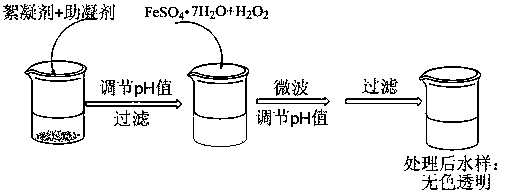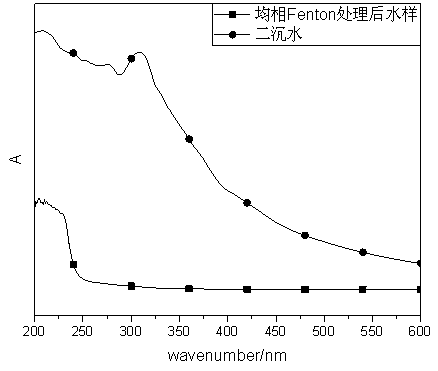Flocculation and microwave-Fenton technology method for deep treatment of organic wastewater
A technology of organic wastewater and advanced treatment, applied in water/sewage treatment, water treatment parameter control, special compound water treatment, etc. It can solve the problems of high pollutant concentration, refractory degradation, poor biodegradability, etc., and achieve good treatment effect. , the effect of short reaction period and simple reaction process
- Summary
- Abstract
- Description
- Claims
- Application Information
AI Technical Summary
Problems solved by technology
Method used
Image
Examples
Embodiment 1
[0025] In this example, Fe 2+ / H 2 o 2 The mass ratio is 1:4.6, and the organic wastewater is treated by flocculation + microwave-Fenton method.
[0026] Take 200ml of raw water in a beaker, add 350mg / L PAC solution, stir rapidly for 1 minute, then add 3mg / L PAM solution, stir slowly for 1 minute. Let it sit for a while. Precipitate, separate, and take the supernatant.
[0027] Adjust the initial pH of the supernatant to 4, then add FeSO with a ratio of 1:4.6 4 ·7H 2 O and H 2 o 2 ; Microwave for 20min. Adjust the pH of the wastewater to 6-7, filter the supernatant to measure the COD value and chromaticity. The organic wastewater sample treated in this embodiment has a COD removal rate of 76.5% and a chroma removal rate of 83.6%.
Embodiment 2
[0029] In this example, Fe 2+ / H 2 o 2 The mass ratio is 1:4.6, and the organic wastewater is treated by flocculation + microwave-Fenton method.
[0030] Take 200ml of raw water in a beaker, add 300mg / L PAC solution, stir rapidly for 1 minute, then add 5mg / L PAM solution, stir slowly for 1 minute. Let it sit for a while. Precipitate, separate, and take the supernatant.
[0031] Adjust the initial pH of the supernatant to 4, then add FeSO with a ratio of 1:4.6 4 ·7H 2 O and H 2 o 2 ; Microwave for 20min. Adjust the pH of the wastewater to 6-7, filter the supernatant to measure the COD value and chromaticity.
[0032] The organic wastewater sample treated in this embodiment has a COD removal rate of 80.5% and a chroma removal rate of 81.3%.
Embodiment 3
[0034] In this example, Fe 2+ / H 2 o 2 The mass ratio is 1:4.6, and the organic wastewater is treated by flocculation + microwave-Fenton method.
[0035] Take 200ml of raw water in a beaker, add 300mg / L PAC solution, stir rapidly for 1 minute, then add 5mg / L PAM solution, stir slowly for 1 minute. Let it sit for a while. Precipitate, separate, and take the supernatant.
[0036] Adjust the initial pH of the supernatant to 4, then add FeSO with a ratio of 1:4.6 4 ·7H 2 O and H 2 o 2 ; Microwave for 25 minutes. Adjust the pH of the wastewater to 6-7, filter the supernatant to measure the COD value and chromaticity.
[0037] The organic wastewater sample treated in this embodiment has a COD removal rate of 80.3% and a chroma removal rate of 88.4%.
PUM
| Property | Measurement | Unit |
|---|---|---|
| wavelength | aaaaa | aaaaa |
| decolorization rate | aaaaa | aaaaa |
| decolorization rate | aaaaa | aaaaa |
Abstract
Description
Claims
Application Information
 Login to View More
Login to View More - R&D
- Intellectual Property
- Life Sciences
- Materials
- Tech Scout
- Unparalleled Data Quality
- Higher Quality Content
- 60% Fewer Hallucinations
Browse by: Latest US Patents, China's latest patents, Technical Efficacy Thesaurus, Application Domain, Technology Topic, Popular Technical Reports.
© 2025 PatSnap. All rights reserved.Legal|Privacy policy|Modern Slavery Act Transparency Statement|Sitemap|About US| Contact US: help@patsnap.com



